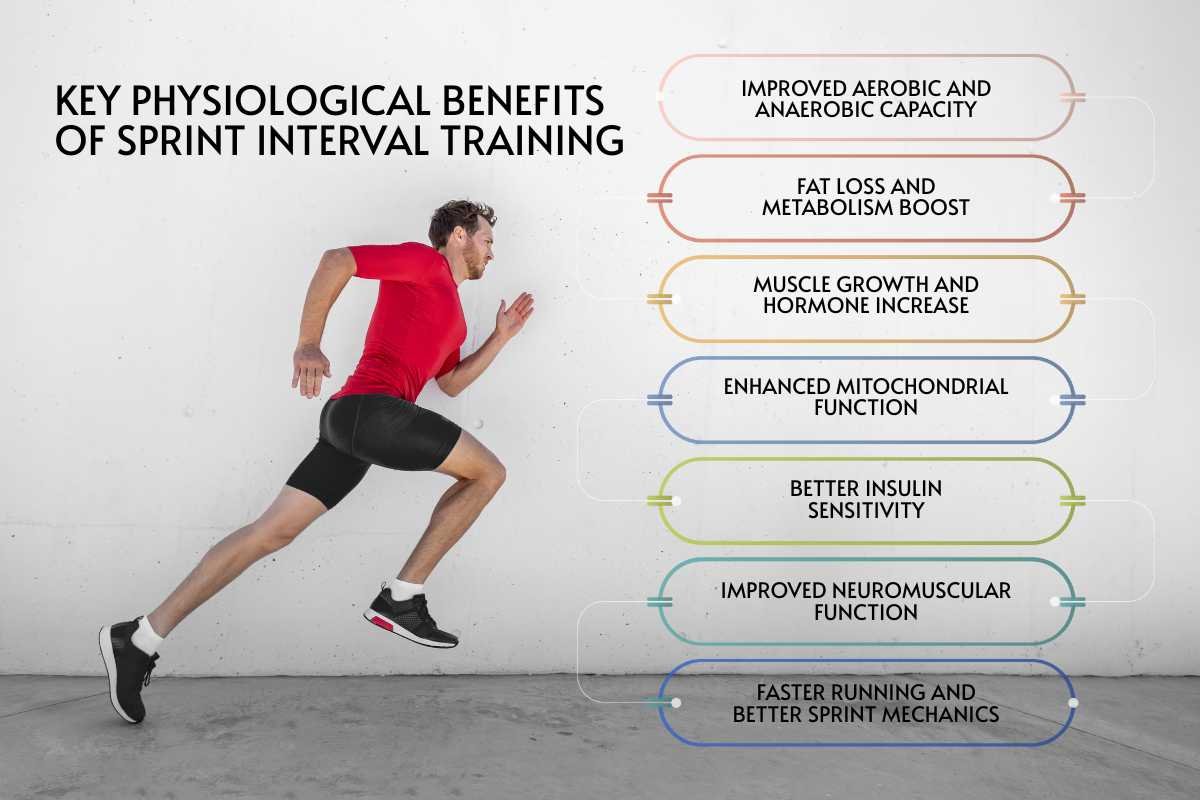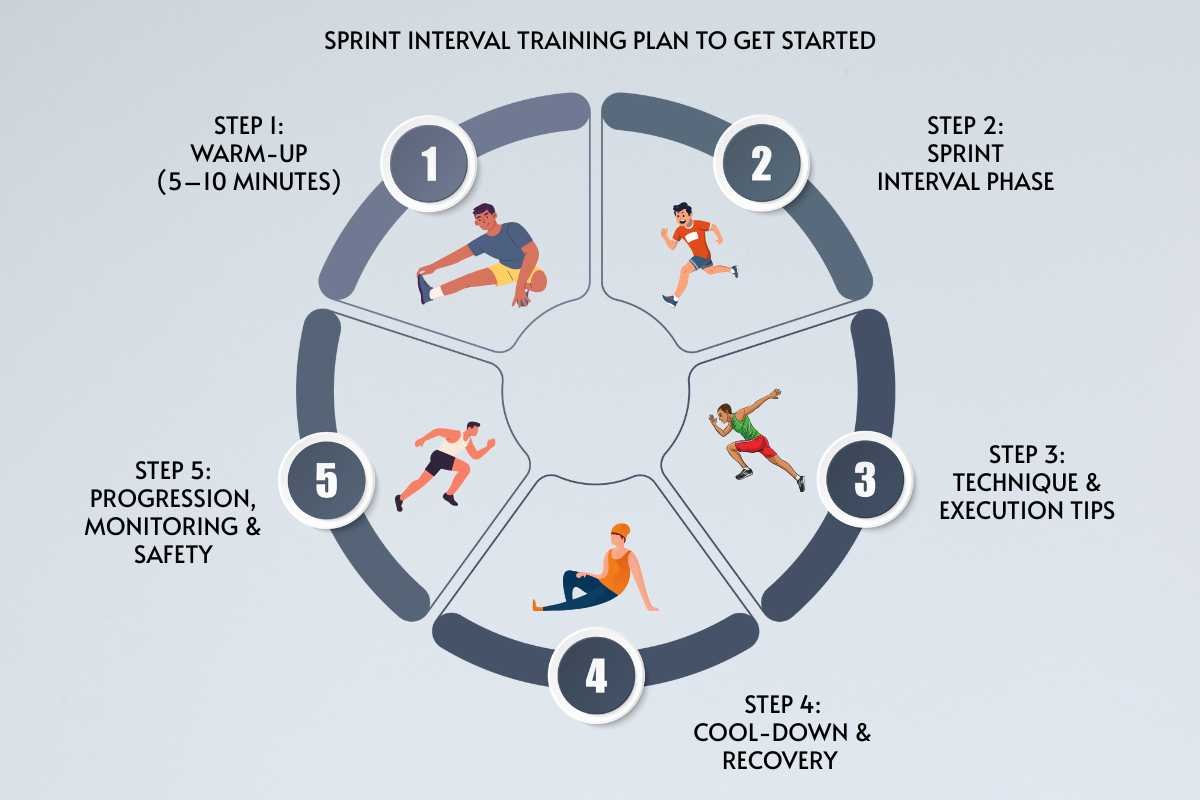Are you wishing you could be fit and healthier? But think there’s no way to do so without many hours spent at the gym. What if I told you there is a way to increase your fat loss potential? Also, adds to endurance performance and improves body composition. All of these in a workout that lasts only a few minutes? It may sound too good to be true, and at the very least, it is all a little mysterious. But there is quite a movement afoot to replace your long, arduous gym sessions. And change them to something far more time-efficient and effective.
Think about a workout so powerful. That it affects continues long after you finish. It challenges your body in short. It is an explosive burst to shed stubborn fat. And transform your cardiovascular health. If you’re ready for a game-changing approach that fits any busy schedule. Then read on to unlock the secrets of Sprint Interval Training.
What is Sprint Interval Training?
Sprinting Interval Training, often called SIT. It is an advanced form of interval training. This alternates short bursts of maximal sprinting effort. With longer periods of rest or low-intensity exercise. This protocol is designed to maximize both aerobic and anaerobic fitness. In a time-efficient manner to support a busy lifestyle.
Each sprint is usually done at maximum or near-maximum effort for a short time. Like 10–30 seconds, that is followed by enough rest. It can often be a few minutes. It helps to recover before starting the next sprint.
Along with reducing maximum time consumption for your usual workout at the gym. This training program also offers benefits. Let’s have a look at them.
Key Physiological Benefits of Sprint Interval Training:
This Fitness program produces several major physiological benefits. That makes it a highly effective workout for cardiovascular, muscular, and metabolic health. Here are some core benefits:

- Improved aerobic and anaerobic capacity: SIT improves the anaerobic capacities of the heart. It also helps to deliver oxygen. And the muscles’ ability to work without oxygen. This leads to better endurance and explosive power.
- Fat loss and metabolism boost: SIT burns more fat in less time and elevates the body’s metabolism for hours. Even after finishing the workout. Due to “excess post-exercise oxygen consumption” (EPOC).
- Muscle growth and hormone increase: SIT stimulates fast-twitch muscle fibers. This raises levels of growth hormone and testosterone. And it also supports muscle building.
- Enhanced mitochondrial function: It increases mitochondrial density and efficiency. This helps muscles use energy more effectively. It ends up improving endurance and performance.
- Better insulin sensitivity: This reduces risk factors for diabetes. It also improves the body’s control over blood sugar.
- Improved neuromuscular function: SIT sharpens coordination between the nervous system and muscles. Leading to greater force output and reduced fatigue.
- Faster running and better sprint mechanics: Increased muscle fiber recruitment. This improves speed, strength, and efficiency in both short sprints and longer runs.
Core Components of an Effective Sprint Interval Training Program:
There are some elements in this training program that we need to be aware of. These component helps make your workout effective. They also increase your understanding of this sprinting training routine.
- Warm-Up: Begin each session with light aerobic activity and dynamic stretches. This helps prepare muscles and joints. Helps prevent injury and allows for maximum performance in sprints.
- Intensity of Sprints: Sprint intervals should be performed at 90–100%. Mainly of maximum effort, typically for 10–30 seconds. This high-intensity phase is critical for triggering physiological benefits.
- Adequate Recovery: Each sprint is followed by a recovery or rest period lasting 2–4 minutes. Usually at low intensity (walking or very easy jogging). This allows for partial recovery and energy replenishment.
- Repetitions: A session usually involves 4–8 sprint–recovery cycles. Beginners may start with fewer intervals and increase over time.
- Cool-Down: End with light aerobic activity and stretching. This promotes recovery, aids in removing waste products, and reduces muscle soreness.
- Progression: Start with fewer intervals and longer recovery periods. Then gradually increase the number of intervals. Or decrease recovery time as fitness improves.
- Customization: Adjust the number of intervals. With sprint duration and rest lengths based on fitness level, goals, and sport. SIT can be performed with different exercises like running, cycling, or swimming.
- Strength and Technique Work: Some programs include bodyweight strength circuits. Sprint technique drills as part of the routine. This is for a more comprehensive fitness effect.
Example Structure
- Warm-up: 5–10 minutes
- Sprint Interval: 20–30 seconds at all-out effort
- Recovery: 2–4 minutes, easy movement
- Repeat: 4–8 cycles
- Cool-down and stretch: 5–10 minutes
Also Read:
- Stop Wasting Hours on Cardio: Try This Proven Sprint Workout Plan Instead
- Want Speed and Strength? Try These Best Sprinting Workouts Proven by Science
Safety, Technique, and Recovery in Sprint Interval Training:
Safety
- SIT is intense and requires a good baseline fitness level. Beginners should gradually build cardiovascular fitness before attempting it.
- People with injuries like ankle, knee, and hip. Or chronic pain, heart conditions, or high blood pressure. They should consult a healthcare professional before starting SIT.
- Proper footwear and clothing help prevent injury. And improve comfort during workouts.
- Avoid doing SIT on consecutive days. It allows 1-2 days between sessions for recovery.
- Start slowly, beginning with two SIT sessions per week. Then progress gradually by increasing intensity, repetitions, or frequency.
Technique
- Warm up with dynamic stretches and light aerobic moves. This helps prepare muscles and joints.
- Focus on sprinting form. Like upright posture, strong knee drive, active arm swing, and mid-foot strike.
- Engage core and glute muscles to maintain stability and power.
- Perform sprints at near-maximal intensity. This can be about 90–100% effort. And maintain speed through proper mechanics.
- Avoid overstriding and ensure smooth, controlled landings to reduce injury risk.
Recovery
- Recovery periods between sprints typically last 2–4 minutes. Also, involve low-intensity activity like walking or slow jogging. This helps replenish energy stores.
- Active recovery, such as moving lightly during rest phases. It can improve endurance adaptations better than complete rest.
- Cool down after sessions with light jogging and static stretching. This facilitates muscle recovery and reduces tightness.
- Adequate rest days and sleep are essential. It lets muscles repair and adapt to training stresses.
- Nutrition and hydration support recovery. By replenishing energy and aiding muscle repair.
Sprint Interval Training Plan to Get Started:
Below is a structured, evidence-based protocol. You can use these steps to perform it:
1:4 Sprint Interval Training (SIT) Workout. For Better Body Composition & Stamina by Laura Torbett:

Step 1: Warm-Up (5–10 minutes)
- General movement — 2–3 minutes of light jogging, brisk walking, or easy cycling to get blood flowing.
- Dynamic drills — High knees, butt kicks, leg swings, walking lunges, high skips.
- Activation work — Glute bridges, plank variations, light bounding, skipping to prime muscles.
- Strides — 2–3 short 20–30 m accelerations (70–80% effort) to get the neuromuscular system ready.
Step 2: Sprint Interval Phase
You’ll alternate between all-out sprints and recovery. Typical parameters might be:
- Sprint duration: 15–30 seconds
- Recovery (rest) duration: 30 s to 2 min (active walk or jog, or passive)
- Number of sprints (reps): 4–8 per session
- Rest between blocks / sets: If multiple rounds, give a longer rest (2–4 min) between blocks
Here’s a sample progression:
| Level | Sprint | Recovery | Rounds / Blocks |
|---|---|---|---|
| Beginner | 15 s max effort | 60 s walk / jog | 4–6 reps |
| Intermediate | 20–25 s | 60–90 s | 6–8 reps |
| Advanced | 30 s | 90–120 s | 6–10 reps or in multiple blocks |
Step 3: Technique & Execution Tips
- Posture: Slight forward lean (from ankles, not hips), keep core engaged.
- Arm drive: Bent elbows 90°, drive arms forward-backward (not across body).
- Stride: Quick turnover rather than overstriding; maintain cadence.
- Foot strike: Midfoot to forefoot (depending on your biomechanics) — avoid heavy heel strikes.
- Relaxation: Don’t tense shoulders or hands; breathe rhythmically.
- Incremental buildup: If new, start with fewer reps or a shorter duration, then scale up.
Step 4: Cool-Down & Recovery (5–10 minutes)
- Easy movement — 2–3 minutes walking or slow cycling to flush out metabolic byproducts.
- Static stretches — hamstrings, quads, calves, hip flexors.
- Foam rolling / soft-tissue work — as needed, especially in glutes and hamstrings.
- Hydration / nutrition — rehydrate, consume protein + carbs (if appropriate) to support recovery.
- Rest / sleep — allow adequate rest, especially if doing multiple hard sessions per week.
Also Read:
- Unleashing the Power of High-Intensity Interval Training (HIIT) for Optimal Fitness
- Why 10-Minute HIIT Workouts Are Better Than an Hour at the Gym?
- Your No-Nonsense Guide to HIIT Workout for Female Beginners
Step 5: Progression, Monitoring & Safety
- Tracking: Measure heart rate, perceived exertion (RPE). With sprint times over fixed distances, and recovery heart rates.
- Progress gradually: Add one sprint, increase sprint duration. Or shorten recovery only when the prior load is easily managed.
- Listen to your body: If you feel sharp pain, unusual fatigue, or dizziness, stop or scale back.
- Health considerations: People with cardiovascular, joint, or metabolic issues. They should consult a health professional before doing all-out sprints.
- Frequency: 1–3 SIT sessions per week is typical. It combines with lower-intensity work on other days.
Case Study:
Six Sessions of Sprint Interval Training. A Time-Efficient Path to Better Endurance

A recent case study on trained trail runners revealed. That’s just six sessions of Sprint Interval Training (SIT) over two weeks. It significantly boosted endurance, power, and running performance. Using simple shuttle-run protocols. The athletes improved their 3,000m time trials by nearly 6% and extended time to exhaustion by over 40%. The findings confirm that Sprint Interval Training is highly effective and cost-efficient. Making it a powerful tool for athletes and coaches seeking rapid performance gains.
Source: https://pmc.ncbi.nlm.nih.gov/articles/PMC5839711/
Conclusion
We have finally uncovered the mysterious and time-efficient workout. After some investigation of what you have been looking for. Sprint Interval Training is more than a trend. It is a workout with scientific backing. It is especially designed to revolutionize your fitness regimen. By exchanging lengthy, torturous hours for a few minutes of true intensity. You have just revealed a powerful weapon for increased stamina and endurance. It also improved metabolism and a stronger body.
We have now provided the information, the plan, and the specific steps to implement it. Now you just need to begin. Are you ready to see? What can your hardest minutes of work and effort produce in return?
Also Read:
- Exercising at Home: Unlocking Simple Ways to Stay Active and Healthy
- Is a Stationary Bike Workout Really Effective? Here’s Some Science behind it
- Best Sports for Losing Weight: A Fun and Effective Way to Shed Pounds
FAQs:
1. What is Sprint Interval Training, and how is it different from HIIT?
Sprint Interval Training (SIT) is a form of high-intensity exercise. It alternates between all-out sprints and recovery periods. Unlike HIIT, which often uses submaximal effort and varied exercises. SIT emphasizes near-maximal sprinting, usually in short bursts of 15–30 seconds.
2. What are the main benefits of Sprint Interval Training?
SIT improves cardiovascular health and increases VO₂ max. It improves fat burning and boosts insulin sensitivity. It also saves time compared to traditional cardio workouts. Many studies show you can achieve significant results in under 20 minutes.
3. What should I eat before and after Sprint Interval Training?
Before SIT, opt for a light meal or snack that is easily digestible. That can be carbs and some protein, like a banana with yogurt. Afterward, focus on protein for muscle repair and carbs. For glycogen replenishment, ideally within 1–2 hours.







